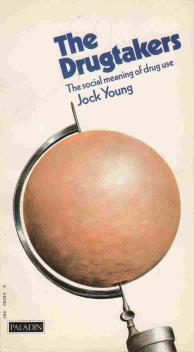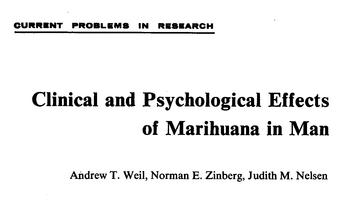
|
In
1971
The Drugtakers. The Social Meaning of
Drug Use by Jock Young was published.
See the crime timeline The extracts below deal with the interaction of biology, psychology and sociology. The same relationships were taken up, in a different context, by Jock in The New Criminology in 1973 when he discussed Eysenck's conception of human nature On another page you will find Olorumyomi Omowunmi's outline of Jock Young's division of social perspectives into absolutist and relativist |
Chapter 2 The Social Basis of Drug Dependency
... the nature of dependency and the life of the drugtaker cannot be understood merely in terms of the drug. Heroin addicts in Britain, in the United States, in Hongkong, in Japan all take the same drug but the pattern of their addiction is remarkably different.
The social reaction against the drugtaker, the policies which are designed to control the drug, have remarkable effects on the role within which the drugtaker finds himself. For example, in the United States he is cast as a criminal, he is legally harassed, he is forced into crime (thus substantiating the stereotype) in order to find money for the high black market prices. As a consequence of this illegality organized crime grows up as an unintended consequence of the narcotics legislation. An exploitative culture is set up which dominates the life of the addict. The very strength of the drug is low, variable and adulterated, this having very tangible effects on the type of addiction found in the States. Death itself is not an inevitable consequence of the drug heroin but is related to these exigencies of the market. The addict is periodically and coercively institutionalized, he is subject to therapeutic onslaughts from a body of experts who have themselves particular conceptions of the 'essential' nature of the addict. Criminal exploitation, police harassment, therapeutic correction, social stigmatization all give rise to a culture partly defensive against these agencies, partly introjecting and accepting their notions of him, altogether an adaption to his situation.
It is not then the study of drugs in a vacuum, as isolated pharmacological effects, which will help us understand drug addiction; rather it is the social meanings ascribed to a particular drug in a specific society or culture that we must analyse. But further than this: it is not only the life style of the addict which is shaped by social forces; the very effects of the drugs themselves are intimately related to the social values, expectations and milieu in which they are taken.

|
In 1968, N. Zinberg and A. Weil performed the first controlled experiment on the effects of marihuana. They compared the effects of smoking the drug on a series of naive subjects contrasting them with a control group of chronic users. |
|
Lest she be fogotten:
Judith M. Nelson. Research Fellow at the
National Institute for Mental Health.
Andrew Weil -
Norman E.
Zinberg
Sample size "The central group of subjects consisted of nine healthy, male volunteers, twenty-one to twenty-six years of age, all of whom smoked tobacco cigarettes regularly but had never tried marijuana previously. Eight chronic users of marijuana also participated, both to "assay" the quality of marijuana received from the Federal Bureau of Narcotics and to enable the experimenters to standardize the protocol, using subjects familiar with their responses to the drug. The age range for users was also twenty-one to twenty-six years. They all smoked marijuana regularly, most of them every day or every other day." Control The control was not provided by a control group but by giving each group a placebo at some sessions and the real thing at others. |
Comparison of the effect of marihuana on naive and chronic smokers
| Naive subjects | Chronic users | |
| 1. pulse rate | increase | significantly greater increase |
| 2. respiratory rate | no increase | small but significant increase |
| 3. blood sugar level | no change | no change |
| muscular coordination | decreased performance | performance slightly improved |
| cognitive functioning | decreased performance | slight improvement |
| judgement time | impaired | impaired but conscious allowance made for distortion |
| pupil size | no change | no change |
| conjunctival reddening | occurred | occurred |
| subjective effects | little understandable effect | euphoria, high |
As can be seen, the only common effects between users and naive subjects were conjunctival reddening, increase in pulse rate and distortion of time sense. Blood sugar level and pupil size did not alter, disproving much of the literature. But the most important finding was the divergent effects found between the naive subjects and chronic users. Both motor and cognitive performance improved in the regular users but deteriorated in the naive subjects. The latter did not feel any euphoria whereas the users experienced a characteristic high. Moreover, the naive subjects had only a slight increase in pulse rate and no increase in respiratory rate whereas the chronic users had an increase on both counts.
Examining this data, Zinberg and Weil note how:
"there are suggestions in this study - like greater increase in the heart rate and respiratory rate of chronic users - that users and non-users react differently to the drug not only subjectively but also physiologically" (p. 86).
To explain this, the authors suggest two hypotheses:
1. That marihuana has a cumulative effect in the body. This they reject as unlikely because once a user is able to get high, the amount of drug necessary remains the same.
2. That some sort of pharmacological sensitization occurs giving rise to a unique example of 'reverse tolerance', i.e., unlike other drugs - such as alcohol - one does not become more but less tolerant of its effects. This I feel is not substantiated by the evidence: a user, for example, can quit smoking marihuana for several years but can come back to it and experience a high readily. Rather I wish to suggest a third hypothesis:
3. That chronic users learn to experience a high and that this learning process has physiological consequences. In other words, that the subjective and physiological levels are tightly interrelated and users in the process of achieving a high effect changes on their own metabolism. This notion is akin to the classic trauma reaction in the individual, where he subjectively experiences fear and this fear translates itself on the physiological level in the release of adrenaline into his bloodstream. Fear is a socially defined process where the subjective state of the individual effects his metabolism and, moreover, fear like a high is experienced by the individual as a subjective mood which is automatically substantiated on the bodily level. But this is, of course, only half of the process. Drugs by their very nature affect the metabolism of the individual, but the ways the individual interprets these changes in his body are related to his own subjective notions of what is happening to him. What I am arguing is that a two-way process occurs in drugtaking: the drug alters the metabolism of the individual, he interprets these bodily changes into subjective experiences according to his expectations, social situation and prevailing mood, and these subjective experiences react back on to and change the already altered metabolism. In short, the drug experience can only be understood in terms of an ongoing dialectic between the subjective mood of the individual and the objective psychotropic effects of the drug. I wish now to turn to the various authors who have studied precisely this type of relationship.

|
H. S. Becker, in his classic article 'Becoming a Marihuana User', [1953, Referenced to Outsiders 1963] outlines the learning process involved in marihuana use. The novice - the naive user - does not experience a high at first; he may feel, it is true, slightly strange but that is all; he is unable to interpret the meaning of the physiological sensations that he is experiencing. Indeed, as Becker notes, the novice may feel nothing at all has happened to him - he may feel totally cheated by the drug - and it is not until a sophisticated user has indicated to him the likely effects that he realizes that he is in fact being affected by the drug. Moreover, it is not until the naive user learns firstly how to smoke marihuana and then - more importantly - how to interpret his feelings as pleasurable that he experiences a high. Before this the effects of the drug are physically unpleasant or at least ambiguous.
A situation very similar to this exists with the opiate drugs. Thus
Lindesmith writes:

|
Lindesmith in another context writes:
The effect of subjective beliefs on the metabolism of the individual is clearly indicated when 'fake' withdrawal symptoms are evidenced by individuals who are in fact not at all addicted. Lemert notes in a similar vein how pharmacological generalizations about alcohol are often manifestly applicable to particular cultures only:
|
Alcohol 
|
"At this point it is necessary to interject a note of caution with reference to various physiological and psychological studies on the effects of alcohol consumption. We should not let ourselves forget that the subjects for these investigations have been drawn from our own culture and that there are very few cross-cultural studies of the physiology and 'psychology' of alcohol ingestion. Such comparative studies as have been made raise more than fleeting doubts that what often passes for constant 'physiological effects' of alcohol in American research in reality may be manifestations of a variable cultural overlay. Thus, for example, in one study of the function of alcohol in a primitive Mexican culture located in the mountains of Chiapas few of the more extreme types of behaviour which arise in connection with intoxication in our culture were found to occur. There, in the stage of feeling high, native men could play guitars or handle a machete with perfect safety. In extreme intoxication there seemed to be less interference with speech than that observable in inebriation in our culture, and even in stuporous states the natives carried through with familiar routines and transacted complicated business of which later they had no memory. There seemed to be very little vomiting after overindulgence, and there was little evidence of hang-overs beyond mild tremors and shakiness. Little fighting arose in drinking parties, and there was no evidence of lowered inhibition in erotic behaviour. These people typically drank for the sense of warmth it induced and as a prelude to sleep." |
It is impossible then to make generalizations about the effects of drugs in a vacuum. For the effects of drugs are shaped by the culture of the user and are learned by the novice from the more sophisticated drugtaker. To this extent, the effects of a particular drug form a role Such roles are the heavy drinker, the comic drunk, the cool marihuana smoker, the righteous dope fiend.
Now and then deviations occur from these roles especially when an overdose of a particular drug puts the individual in a position where he cannot control the effects he is experiencing. But drug groups contain lore of administration, dosage and use which tend to keep this lack of control in check, plus, of course, informal sanctions against the person who goes beyond these bounds. Witness the shame experienced by the man the morning after who hasn't been able to hold his liquor or the LSD user who has freaked out and has to be talked down (i.e., back to normative limits) by his fellows.
|
History, Culture and Subjective Experience: An Exploration of the Social
Bases of Drug-Induced Experiences
Howard S. Becker
Journal of Health and Social Behavior
Vol. 8, No. 3 (September 1967), pp. 163-176
Abstract: So-called "drug psychoses" can be interpreted as the anxiety reaction of a naive user occasioned by his fear that the temporary symptoms of drug use represent a permanent derangement of his mind. Participation in a drug-using subculture tends to minimize such occurrences, because other users present the person with alternative explanations of his experience that minimize its lasting effects. A comparison of LSD and marihuana use suggests that the number of drug-induced psychoses varies historically, being a function of the historical development of a subculture.
|
Not all drugs, of course, have finely spun norms surrounding their use, and even where such norms do exist, not all people have a working knowledge of them. Becker has suggested that in these instances there is a high incidence of psychosis associated with drug use. Psychotropic drugs have, by definition, effects on the subjective experience of individuals. If there is a body of culture available to interpret these experiences, to say that such and such a mental state is pleasant - or at least normal in the circumstances - then the individual will feel in control of the situation. But if he has perceptual distortions, hallucinations, physical sensations which he does not know how to interpret, he may well think that his sanity has become impaired, that his mind is out of control. Such unstructured drug experiences may trigger off bouts of extreme alarm and anxiety. Unfortunate mental or physical harm to the individual may ensue from such a panic. Moreover, Becker notes that in the absence of a drug subculture the isolated individual's only knowledge of the effects of the drug which he has taken may derive from the mass media. Such reports are invariably 'newsworthy', that is they emphasize bizarre, psychotic effects of drugs. The individual's interpretation of his experiences may thus be both shaped and understood in alarming terms. Furthermore, even if he seeks help from a physician his fears may remain undiminished; for the psychiatrist will often regard dabbling in drugs as indicative of personality problems and his diagnosis will merely confirm the patient's suspicions about himself. Becker substantiates his thesis by referring to the history of marihuana use in America, noting how, as a subculture concerned with its use built up, the reports of cannabis psychosis gradually disappeared. This is corroborated by events in this country where in the fifties it was quite common to hear of individuals who experienced the horrors after smoking marihuana but such incidents - despite the increase in marihuana smokers - are rarer today.
 Study
links outside this site
Study
links outside this site
 Picture introduction to this site
Picture introduction to this site
 Andrew Roberts' web Study Guide
Andrew Roberts' web Study Guide
 Top of
Page
Top of
Page
 Take a Break - Read a Poem
Take a Break - Read a Poem
 Click coloured words to go where you want
Click coloured words to go where you want
Andrew Roberts likes to hear from users:
To contact him, please
use the Communication
Form

Index
